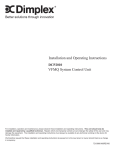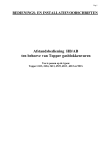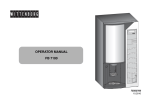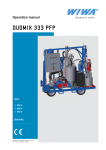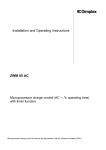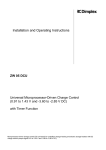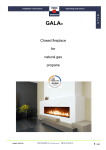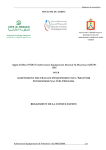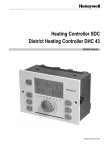Download Unical GHISS 24R AE Technical data
Transcript
® GHISS 70, 90, 110, 125, 145, 160, 180, 200 MAX R AE INSTRUCTIONS FOR USE AND OPERATING MANUAL STANDING GAS DEVICE WITH CAST-IRON SEGMENTED HEATEXCHANGER, SPARK IGNITION, IONISATION FLAME-CONTROL AND BI-LEVEL BURNER 1. VERZIÓ HU CONFORMITY GHISS …MAX R AE, boilers have been attested according to the following European standards: o 90/396/CEE gas directive o 92/42/CEE efficiency directive o 89/336/CEE electro-magnetic conformity directive o 73/23/CEE low current directive TABLE OF CONTENTS GENERAL Conformity......................................................................2 Important things to know.................................................3 Basic safety rules ...........................................................3 General introduction .......................................................4 Identification...................................................................4 Construction...................................................................4 Technical data................................................................6 Hydraulic operation ........................................................7 Pump .............................................................................7 Electric switching diagrams ............................................8 Operating surface...........................................................9 Dear Customer, Thank you for choosing the gas boiler of Unical. With this, you have become the owner of an efficient device of high technical level and safe operation. Congratulations! Check the complete and intact condition of the product! Do not remove and do not damage the signs to be found on the device! The present document is the operating – maintenance manual. The guarantee slip located in the attachment is to be stamped and filled in legibly on the occasion of the purchase and commissioning! We request that – in your own interest – you carefully read the information described on the following pages, and keep them because you might need them in the future. If you take our advice, our product will serve you reliably for long years. HANDLING THE DEVICE Turning on....................................................................11 Setting the boiler thermostat .........................................13 Temporary shut-down...................................................13 Shutting down for a longer time ....................................14 Cleaning.......................................................................14 Maintenance ................................................................14 INSTALLING THE DEVICE The documentation of the product ................................14 Sizes and weight ..........................................................14 The boiler room ............................................................16 Connecting the boiler to the existing old heating system16 Hydraulic connection ....................................................16 Electric connections .....................................................17 Gas connection ............................................................18 Channeling combustion products..................................18 Filling up and draining the system.................................19 SERVICE INSTRUCTIONS Preparations for start-up ...............................................19 First start-up.................................................................19 Checking during operation ............................................21 Shutting down for a longer time ....................................22 Maintenance ................................................................22 Regulation....................................................................23 Switching to other types of gas .....................................24 The cleaning of the boiler .............................................25 The operating manual contains the following symbols: Warning = the activity requires greater attention! Ban = this activity must not be carried out! 2 GENERAL VERSION 1 GB IMPORTANT THINGS TO KNOW After you have unwrapped the device, check whether it is intact and complete. Upon planning and execution, the valid requirements of the local gas provider, the construction industrial and environmental standards, and the prevailing electric and other standards must be taken into consideration and must be abided by to the full. The manufacturer cannot take responsibility for unprofessional operation and other mechanical injuries that emerge from unprofessional operation. In case of failure, if you cannot eliminate the failure on the basis of the instructions of the manual, call the appointed brand service station. Check the pressure of the heating system regularly, and do not let it drop under 1 bar. If the device repeatedly shuts down blocking, on several occasions call the brand service; in the meanwhile, do the following: o Turn off the main switch of the device o (cut off the current). o Shut of the connected gas and water supply. o In case of frost danger, drain the heating and HWU water cycles (draining). In the interest of safe and economic operation, it is practical to have the control examination recommended by the manufacturer and the necessary maintenance jobs carried out on the device by the appointed professional service station at least once a year. BASIC SAFETY RULES The user is to pay attention to the fact that this device uses gas, electric energy and water during its operation, which poses some basic safety rules: The boiler must not be used by children and non-authorised persons. Do not use electric devices, machines, equipment, do not turn on the light if you can smell gas. In this case, close the gas tap, air the room and call the professional service. Do not touch the boiler with wet hands or if you are in your bare feet. Do not clean the boiler while it is on and is operating. Only the authorised professional service station can replace safety and other parts in the device, and only with the original factory-identical parts. Do not pull or twist the connection cable of the boiler while it is live. The operation of the device requires air supplement, therefore, do not cover or close, and do not narrow down the vents or windows that can provide the supplement of air necessary for burning. Because of the danger of freezing, do not install the boiler in an open room. Do not store packaging materials (cardboard paper, plastic or wood) and combustible or explosive materials close to the boiler. This operating manual contains all the important information for the user in connection with the use of the device, therefore, it is practical to keep it close to the boiler. If the device is sold or relocated, this operating manual is always to accompany it so that the new owner and/or mechanic can be advised properly. 3 GENERAL VERSION 1 GB GENERAL INTRODUCTION Basic model, atmospheric furnace chamber hot water gas boiler with cast-iron segmented heat-exchanger. It is suitable for the realisation of the pump-system central heating of residential and public buildings and – together with the indirectly heated hot water containers that can be installed next to them – for the realisation of the hot water supply for use, as well as for any industrial-purpose application where the 40-80 °C water temperature range of regulation is suitable. Its operation provides the following variations of comfort: Winter operation: heating and/or hot water production (the latter with preference) Summer operation: only hot water production (heating demand switched off) Execution: with built-in automatic purging valve and safety blow-off valve. The operation of the burner system of the device: The device has a three-point regulation, where the control regulates the burner system of the device in such a manner that if the temperature of the boiler is over 6 °C below the set value, it keeps it at nominal output, if between 6 °C and the set value, at partial load, if it exceeds the set value, it switches it off. Its operation is possible with piped natural gas (“H” or “S”), (I2H,S). The gas fittings are provided with pressuregage studs of the appropriate formation, which are suitable for the measuring of the connection (gas network) pressure and the burner pressure (before the nozzles). The nominal, operating parameters of the boiler are to be found in the “technical data” table. The regulation of the boiler control is digital. The devices contain weather-dependent heating control. With room thermostats of daily and weekly programming, the possibilities can be extended even further. Type of the conduct of combustion products: B11BS IDENTIFICATION The data plate serving the identification of the boiler can be found after the removal of the door of the device, on the inside wall of the left-side housing. Do not remove the data plate and do not damage it! This data plate contains the main parameters of the device and the individual identification information (type, production number, date of production, etc.). 4 GENERAL Important safety functions in the operation of the boiler: 1. The post-circulation of the heating pump until the temperature of the boiler drops under 38 °C. 2. After the HWU operating mode the pump works until the water temperature of the boiler and the temperature of the water are the same. 3. Protection of the boiler: restricting thermostat for the prevention of the over-heating of the heating water. 4. Protection of life: flue gas restrictor thermostat for the prevention of the flow back of the combustion products. 5. Frost-protection function. 6. Protection against the jamming of the pump axle. Structural characteristics The heat-exchanger of the boiler – depending on the required output – is constituted by 5-6-7-8-9-10-11-12 cast-iron segments. Its segmentation – with the insertion of special cone rings – takes place after the segments have been pressed together, with treaded fastening sides. Its insulation is textile fibre-reinforced glass-wool quilt covered with aluminium foil. The gas fittings are provided with pressure-gage studs of the appropriate formation, which are suitable for the measuring of the connection (gas network) pressure and the burner pressure (before the nozzles). The housing of the boiler is aesthetic, covered with electrostatic powder-painting and wear-resistant coating. The material and construction of the structural elements is such that during the course of the proper use of the device – as a result of the mechanical and heat exposure – no lasting changes of shape can take place. VERSION 1 GB CONSTRUCTION The construction and main parts of GHISS …MAX R AE type devices are the following: The construction and main parts of the devices are the following: List of parts: 1. Boiler housing 2. Deflector 3. Automatic purger 4. Forward pipe 5. Dip-casing 6. Manometer 7. Pressure remote transmitter 8. Gas pipe 9. Safety valve 10. Return pipe 11. Instrument box 12. Cast heat-exchanger 13. Burner tray 14. Gas valve 15. Nozzle holder collector 16. Lifting eye 17. Support leg 5 GENERAL VERSION 1 GB TECHNICAL DATA GHISS .. MAX R AE Unit of 70 measurement Technical data Nominal heat load kW Nominal heat output kW Nominal efficiency (water-side) % Min-max operating water temperat°C Water cubic capacity of the boilerdm3 Number of burners / main nozzlesdb (v) Number of cast segments db Heatable space lgm3 Maximum operative overpressurebar Boiler body test overpressure bar Pressure loss (80/60 °C) mbar Connecting sizes Forward, return heating water Inch Gas connection Inch Gas-technical data Piped natural gas Connecting gas pressure mbar Burner nozzle pressure “H” mbar Burner nozzle pressure “S” mbar Burner nozzle diameter “H” Ø/mm Burner nozzle diameter “S” Ø/mm Ignition burner nozzle diameter Ø/mm Heating material amount “H” m3/h Heating material amount “S” m3/h Combustion product data Combustion product channelling Ø Combustion product temperature °C Required draft of the chimney mbar Combustion product cubic capacity Nm3/h NOx –class Electric data Electric connection V/Hz Electric output W Electric protection Shock-proofing class Ignition flame security Ignition Hz/ kV dB Noise level Enveloping sizes Height mm Width mm Depth mm Boiler volume (without water) kg 6 GENERAL 90 110 125 71/49.7 64.6/45.2 89 / 62.3 81 / 51.7 107 / 74.9 97.4 / 68.2 125 / 87.5 143 /100.1 161 / 112.7 179 / 125.3 196 /137.2 113.8 / 79.7 130.1 / 91.1 146.5 / 102.6,1162.9 / 114 178.9 / 125.2 27 4 5 32 5 6 37 6 7 42 7 8 0.6 0.55 0.5 145 45/85 47 8 9 5 (pressure class 2) 8 0.45 0.4 160 180 52 9 10 57 10 11 62 11 12 0.35 0.3 0.25 2½ 1 Classification according to the use of gas: I2H,S 12.8 15 3.5 3.9 12.8 15 3.5 3.9 7.6/5.32 8.84/6.21 9.51/6.66 11.06/7.74 200 136 200 138 1 ½” 20-25 12.9 13 13.1 15.2 15.3 15.4 3.5 3.5 3.5 3.9 3.9 3.9 0.36 11.43/8.0 13.35/9.35 15.27/10.7 117.18/12.0 19.1/13.37 12.29/9.3 15.52/10.87 17.76/12.44 19.98/13.95 22.2/15.55 Classification according to combustion product: B11BS 225 225 225 250 300 139 143 152 155 158 0.06 12.8 15 3.5 3.9 200 12.8 15 3.5 3.9 1 ½” 13.2 15.5 3.5 3.9 20.9/14.63 24.3/17.01 300 160 2. (NOx - concentration < 200 mg /kWh) 230/50 25 IP 20 I. Ionisation 6/15 electric spark max.50 15 15 15 25 789 939 939 1164 215 256 296 336 1095 1164 1170 376 25 25 25 1389 1389 1464 416 456 496 VERSION 1 GB HYDRAULIC OPERATION The hydraulic switching of GHISS .. MAX R AE type devices Several boilers in cascade, separated from the consumers by means of a hydraulic shift lever 3 Radiator heating system 2 5 10 6 3 5 4 3 3 9 Legend: 1. Boiler 2. Radiator 3. Circulation pump 4. Expansion tank 5. Pressure gage 6. Safety valve 7. Rebound valve 8. Indirect container 9. Hydraulic shift lever 10. Mixing valve Radiator heating system and indirect container 7 3 2 3 7 8 PUMP 6 No pump has been installed into these devices as the size of that is to be calibrated primarily for the connecting heating system. The value of the pressure loss emerging on the boiler can be found in the technical table. 5 4 Consumers separated by means of a hydraulic shift lever The pump must not be operated without water! 2 3 Upon the first start-up of the boiler and after a longer period of shut-down, it is practical to check with a screwdriver whether the axle of the built-in pump can be turned. 5 3 4 9 Multiple-boiler cascade connection 2 3 5 6 4 7 GENERAL VERSION 1 GB ELECTRIC SWITCHING DIAGRAMS GHISS .. MAX R AE Legend: 1. 2. 3. 4. 5. 6. 7. 8. 9. 10. 11. 12. 13. 14. 15. 16. 17. 18. 8 GENERAL Hot water for use (HWU) pump Heating pump Room thermostat 1-2 – switch contact, 3 – neutral wire 230 V supply voltage connection, N- neutral wire, L-phase conductor Ignition control Nki- neutral wire, Lb-permanent phase, Lk-connected phase Gas valve – level 2 Error signal in (7/2 – error signal out) Flue gas restrictor Temperature restrictor Water shortage switch Outside temperature sensor HWU sensor Boiler temperature sensor Anti-legionella disabling / enabling The error signal of restrictors and sensors HWU operation disabling / enabling Weather-dependent regulation disabling / enabling Control panel connector VERSION 1 GB OPERATING SURFACE GHISS .. MAX R AE Legend: 1. 2. 3. 4. 5. 6. 7. 8. Steepness regulator Boiler regular and parallel displacement regulator HWU regulator Mode of operation selector Supply voltage turned on (error indication) Nominal output operation Decreased output operation Error indicator and release The operation of the device with automatic weatherdependent regulation - Winter mode of operation: heating and the production of hot water for use. - Summer mode of operation: the production of hot water for use. - “0” switched off mode of operation: frost-protection function and pump periodical coerced start-up function. In the case of a connected exterior temperature sensor and closed JP4 jumper, the forward water temperature will be set automatically by the electronic system, according to the prevailing exterior temperature. This regulation can be influenced with the steepness setting turn knob (1), and the heating regulator turn knob (2), which now functions as a parallel shift regulator turn knob. By setting steepness, we can influence to what extent the change of the exterior temperatures should influence the heating forward value. By increasing the value on the regulating knob, a particular change of the exterior temperatures is followed by a greater change in the temperature of the water. By turning the heating regulator knob, we can modify the whole regulating range, by increasing or decreasing it, which increases or decreases the permanent temperature of the heated rooms. 9 GENERAL The operative processes take place automatically: the electronic device produces sparks, the burner lights, and the gas boiler starts heating up according to the temperature set. - The preparation of HWU: set the required temperature value with the regulating turn knob (3). - Setting the temperature of the heating water: if the exterior temperature sensor is not connected and the JP4 jumper is open, this takes place by setting the heating temperature regulating turn knob (2) at the appropriate value. Shutting down the boiler: turn the mode of operation switch in “0” position. In this mode of operation, the device is still under electricity, thus it is forbidden and dangerous to one’s life to open the switching cabinet and to undo the electric cables! The performance of any repair or maintenance work is possible only if the exterior main switch or the fuse of the device has been turned off! Warning! The ignition cable is marked with red colour, it cannot be switched with the cable of the flame-guard because then the boiler will become unable to operate. VERSION 1 GB Troubleshooting If ignition does not take place automatically, the error indicator lamp press button (8) is lit – the operation of the burner head can be checked through the peephole. Upon pressing the error indicator lamp press button, the error indicator lamp goes out, the automatic ignition process is repeated. switches off, and the pump post-circulates for another 120 seconds. In case of a connected indirect container, the device has an “Antilegionella” function. The function can be switched on by putting the short-circuit caps on the JP1-JP2 jumper legs. With the function turned on, once a week the device heats up the boiler to 65 °C. If the boiler has not been operative for a long time or has not been operated ever, it is natural to repeat the process several times as the gas system filled with air has to be ventilated. When it is turned on, the device starts with this function, and starts the weekly cycles from here. The device is equipped with a temperature restrictor(s), by which security (locked) turning off is performed during the operation of the boiler: In the event of several unsuccessful attempts, call the colleagues of Unical Márkaszerviz. 1. In the case of unsuccessful ignition or missing flame, These types work properly only in the event of phase-spot electric connection! The operation of the gas device The temperature of the heating water can be regulated between 45-80 °C but according to the heating demand, the operating temperature of the boiler is to be chosen in such a manner that the temperature of the return heating water is not lower than 45 °C. Below this temperature, the combustion product may get condensed, and the settling steam may lead to the corrosion and failure of the boiler body. During operation, keep the door of the gas boiler closed! After lighting, the gas burner operates at low output for 30 seconds, then it switches to nominal output. At 38 °C of the boiler water, the circulation pump switches on. When the temperature of the water approaches the set value by 6 °C, the device switches to decreased output. Upon reaching the set water temperature, the main burner switches off. If the forward temperature drops 4 °C below the set value, it switches on again with decreased output. If the forward water temperature keeps decreasing, by 7 °C under the set value, it switches to full output again. Naturally, the heating process described only takes place if the room thermostat is turned on. When the room thermostat is turned off, a heating cycle is finished and a 300-second long interval is started, within which the heating pump post-circulates for 120 seconds or until the heating water drops under 38 °C. The boilers have a frost-protection function. The temperature of the forward water drops under 8°C, a 120-second long watercirculation is started, after which, if the temperature of the water increases above 8 °C, the pump stops, but if the temperature of the water still remains under 8 °C, the circulation cycle starts again. When the temperature of the water drops under 5°C, the decreased output of the burner starts, then after 30 seconds, it operates with full output until it reaches 39°C. Above 39°C, it heats with decreased output until it reaches 45 °C, when the burner 10 GENERAL 2. In case of the intervention of the water temperature separator 96°C, its display is indicator 5. 3. In case of the intervention of the flue gas temperature separator thermostat 90°C, its display is indicator 5. 4. In the event the water pressure switch is turned off. It is strictly FORBIDDEN to eliminate the safety, intervention fixtures! Signs of disorder The LED on the operating surface (5) warns of the possible failure and locked stoppage of the NTC sensors and restrictors by blinking. Attention! The device is allowed to be restarted only after the reason leading to its stoppage has been eliminated! For the re-start, the door of the device is to be opened, and the locking-release button located on the left side of the first connecting sheet must be pressed. Do not miss to use the appointed service station! Do not endanger your safety and the safety of your environment by unprofessional interventions! The flow-back of the combustion product may lead to death! The replacement of broken parts can be carried out only by the appointed professional service station and only with original factory parts! The replacement of broken safety separator thermostats can be carried out only after the operation test of the new part has been performed! Attention! Unical Kft. assumes no responsibility for damage caused by neglecting the above warnings! VERSION 1 GB TURNING ON Automatic mode of operation These devices do not require the manual handling of the gas valve as the device works automatically by simply setting the operating devices placed on the front sheet of the boiler to the desired value, according to the following. - Turn on the exterior mains switch. - Open the gas tap and the water-side closing fixtures. - In the case of the connection of an exterior temperature sensor, set the values of steepness and parallel shifting according to the nature of the heating system and the building. (1, 2) - In case of the manual mode of operation, if there is no exterior sensor, set the boiler regulator thermostat (2) according to the desired temperature. - Set the mode of operation switch (4) according to the desired mode of operation: Winter mode of operation – heating and the production of hot water for use at the indirect container connected to the boiler. Summer mode of operation - the production of hot water for use at the indirect container connected to the boiler. The following processes take place automatically: the electronic system produces sparks, the burner lights, and the gas boiler starts heating-up according to the set temperature value. The setting of the desired hot water temperature at the connected indirect container, with the hot water for use regulator (3). 11 HANDLING THE DEVICE VERSION 1 GB After a long pause of operation, it may happen that the device does not start up. In this case the following is to be checked and performed: o Check whether the taps of the gas and water, as well as of the heating system are open. o Check if the heating system is filled up, there has to be at least 1 bar pressure. o Turn off the exterior separator switch of the boiler, then back on again. o Check the setting of the room thermostat and turn it off and on. o o In the case of manual mode, if there is no outside sensor, set the boiler regulator thermostat (2) at the desired temperature. Set the mode of operation switch into winter mode (4). In the summer mode, the boiler only performs the production of hot water for use if there is an indirect container connected. Otherwise the device does not work in the summer mode setting. 12 HANDLING THE DEVICE VERSION 1 GB o o o The operation of the boiler is started and lasts until the boiler water temperature reaches the set temperature value, or the room thermostat switches off. In the event of an ignition error, the illuminated reset push button lights up with red light. The process of re-starting is the following: - Press the reset push button, - Wait until the ignition procedure is repeated, and operation is started. If the ignition procedure is unsuccessful again, restarting can be repeated after a minute or two. The number of repeated re-starting can be maximum 3. After this call the brand service. SETTING THE BOILER THERMOSTAT When the outside temperature changes, the heating temperature is also to be changed. The colder the outside temperature is, the hotter heating water we need. With weather-dependent regulation this takes place automatically. In the case of manual mode of operation, to increase the temperature of the heating water, the heating temperature regulator button is to be turned clockwise; turning it anti-clockwise decreases the temperature of the boiler. To avoid condensation, the forward temperature set must be at least such that the temperature of the return water is above 40°C. TEMPORARY SHUT-DOWN If, because of a holiday, excursion or some other reason, you want to turn off the boiler, you have to do the following: o Turn the mode of operation switch of the boiler to “0” position, the mains indicator is lit. o 13 You have nothing else to do: in the stand-by mode of operation only the protective functions of the boiler operate, which are frost protection and the axel movement of the pump. HANDLING THE DEVICE VERSION 1 GB SHUTTING DOWN FOR A LONGER PERIOD OF TIME In this case the following is to be done: o Turn the mode of operation switch of the boiler to “0” position, the mains indicator is lit. If there is danger of freezing, drain the water from the heating and HWU systems. CLEANING The outside housing of the boiler can be cleaned with a soft, wet cloth with some detergent. In case of stubborn soiling, removal can be executed with a cloth dampened in the mixture of 50% denaturated alcohol and water. The cleaning of the boiler body and smoke ducts is to be carried out by the professional service station, at regular intervals. o Turn off the exterior separator switch of the boiler. Do not use rough scouring agents! Before you start the cleaning of the boiler, turn off the main switch of the boiler and the exterior separator switch. MAINTENANCE o The regular maintenance and check-up of gas devices is specified by EU directives and standards. Professional and experienced service stations trained for the model secure the following for your device: o Greater security; o Abiding by the legal requirements; o Decreasing the chances of technical failures. Close the water tap. THE DOCUMENTATION OF THE PRODUCT The manual and list of services belonging to the product is placed on top of the device, in a plastic bag, inside the packaging. After the device has been unwrapped, you will find the documentation; read it carefully and abide by the advice and instructions written there. 14 HANDLING THE DEVICE VERSION 1 GB SIZES GHISS .. MAX R AE GHISS MAX 70 90 110 125 140 160 180 200 15 INSTALLING THE DEVICE A 789 939 939 1164 1164 1389 1389 1464 B 1008 1008 1008 1008 1008 1008 998 998 C 320 386 386 487 487 588 588 649 ØD 200 200 225 225 250 250 300 300 VERSION 1. HU THE BOILER ROOM UNICAL GHISS MAX boilers are allowed to be fitted only in rooms where the necessary supply of air (ventilation), required by the standards, is provided for the device, and which meet the fire safety and other requirements. CONNECTING THE BOILER TO THE EXISTING OLD HEATING SYSTEM If we connect the boiler with an old heating system, the following is to be abided by: o The diameter and height of the chimney is to meet the new requirements, it must be of the sufficient cleanness, and provide the necessary amount of draught. Water quality values o The electric system is to meet the regulation requirements of PH the boiler. Electric conductibility < 200 mV/cm (25°C) o The pipes and fixtures of natural gas and gas are to secure the Chloride ion < 50 ppm amount and pressure of fuel required for the boiler according to Sulphuric acid ion < 50 ppm the standards. Sum total iron contents < 0,3 ppm o The closed expansion tank of the system is to be of the Alkaline metals < 50 ppm sufficient size and pre-tension pressure so that it can Hardness of water 35°F compensate for the changes of pressure of the system due to Sulphur ion none changes in temperature. none o The output of the heating circulation pump, as well as the place Ammonia ion Silicon ion < 50 ppm and direction of installation are to meet the new requirements. o The hydraulic system is to be free of air and sediment. This can be achieved by means of the thorough cleaning of the system before connection. Better results can be achieved by means of washing through with chemicals. o The requirements towards the chemical composition of the water of the system can be found in the table. HYDRAULIC CONNECTION The connection place of the heating system and the system of water for use to the boilers is illustrated by the following figure. Choosing the type that best fits the heating system of the building is the task of the designer. If need be, the heating system can also be filled up with anti-freeze liquid. 16 INSTALLING THE DEVICE VERSION 1. HU ELECTRIC CONNECTIONS The devices have the following electric connections. Mains connection 230 V 50 Hz, room thermostat connection, heating and hot water for use pump connection, exterior sensor connection. These connections can be found inside the instrument box, are of serial connection, and are equipped with proper labels. Access is provided in the following way: o o Remove the top of the boiler, which is fastened by snaps. Unscrew the screws of the lid of the instrument box, and you will have access to the connecting switches. There is a 230 V 50 Hz present on the connections of the device, therefore, to avoid accidents, before you remove the lid of the instrument box, turn off the exterior separator switch! o o The connection of the room thermostat may be on two cables or – if the operation of the thermostat requires it – of three cables. The exterior sensor is to be connected with a double-core cable. When connecting the pumps, pay attention to the fact that the connections can be loaded with maximum 1A! If you have to operate a stronger or a 3-phase pump, the exit is to be separated by means of a relay or magnetic switch. 17 SERVICE INSTRUCTIONS VERSION 1. GB 1. 2. 3. 4. 5. The following rules are to be abided by at the electric connections: Connect the mains cable polarity correct to the electric network. The length of this can be maximum 3 m. Marking at the connection: L – phase conductor, N – nil conductor. The recommended cross section of the connecting 2 cables is 1.5 mm , a hose conductor free of injuries. Connection is to be carried out according to the electric connection diagram. The connection of the protective conductor is compulsory. Gas or water pipes must not be used for the protective cable! The boiler and the pipe-system must be connected with the shock-protection system with standard protective conductor. The manufacturer undertakes no liability for incorrect installation! CHANNELING THE COMBUSTION PRODUCTS Connect the boiler with the chimney according to the valid standards and specifications. Connection is to be executed with stiff pipes, providing sufficient caulking, also counting on possibly forming condensation water. The mechanical fastening of the connecting pipes is to be secured against movement and slipping out. The boilers are equipped with flue gas restricting thermostats, which – if the flue gas flows back – switches off the operation of the boiler in a locked manner. The use of an un-insulated exterior chimney poses potential dangers. The connection of GHISS MAX devices to the chimney. GAS CONNECTION Only piped natural gas can be connected to the device. Before you carry out the connection, the following is to be executed: o Check the cleanness of the gas pipe and if necessary, a filter is to be installed before the boiler. The gas connection is to provide gas of the appropriate amount and pressure, and the proper functioning of the measuring and security systems is to be checked. After you have connected the device with the gas system, check the intact condition of the seal and whether the standards are abided by. The air necessary for the operation of the boiler is to be provided through door and windows on the walls of the room or ventilation grates! Providing air, ventilation - - The connecting size of the gas pipeline between 70 and 160 is 1”, and between 180 and 200 is 1 ½”. 18 SERVICE INSTRUCTIONS - The replacement of the air of the room where the device is should be at least five-fold per hour! With devices with an output of over 140 kW, if the value of 3 the load on the air is over 1100 W/m , lamellar opening surfaces are to be provided on the walls or the roof. If the nature of the building does not allow this, it is compulsory to use a gas sensor. Over 3 specific load of 2800 W/m on the air 2 gas sensors operating independent of each other are to be installed! If the air-supply of the room takes place through an opening provided with a closing fixture (flap, mobile shutters, etc.) or through a pipe, the gas supply of the device is to be locked with this. With artificial ventilation, the gas supply of the device is to be locked with the ventilation device in such a manner that in the event of the absence of the ventilation air the device could not be operated. Only blow-in (over-pressure) ventilation can be used for artificial ventilation. VERSION 1. GB FILLING UP AND DRAINING THE SYSTEM No filling-draining tap has been installed into these devices, therefore, upon the establishment of the heating system, the installation of this must be provided at the lowest point of the return pipe. Before you start to fill up, the following is to be done: o Turn off the main switch of the boiler. o Open the filling tap until the pressure of the system reaches 1.5 bar. o Close the filling tap. o Turn on the boiler. Draining: o Before you start draining, turn off the boiler. o Open the draining tap. PREPARATIONS FOR START-UP Before you turn on the device, remove the door of the boiler and check the following: o The taps of the heating system and the gas connection are open. o The type and connection pressure of the gas is suitable for the device. o The pressure of the heating system when cold is over 1 bar, and it has to be free of air. o The pressure of the expansion tank before the system is filled up, must be 0,8 ~ 1 bar. o The connection of the electric system is suitable for the device. o The connection of the combustion product conducting channel (chimney) is suitable. FIRST START-UP Do the following for the start-up of the device: o Turn on the exterior separator switch. o Set the room thermostat for the desired value. o Set the mode of operation switch in winter position. In the summer position, the boiler only produces hot water for use, if there is an indirect container connected and the JP3 jumper is short-circuited. Otherwise the device does not work in summer position. o 19 Set steepness and the parallel shifting regulator at weather-dependent mode of operation, and the boiler regulator thermostat at manual mode of operation, for the desired temperature. SERVICE INSTRUCTIONS VERSION 1. GB The ignition procedure of the boiler starts, sparks are produced automatically, then operates continuously until the boiler or the room thermostat switches off. In the event of an ignition fault, the illuminated re-set push button is lit in red. The process of re-starting is the following: - Press the re-set push button, - Wait until the ignition procedure is repeated and operation starts. It may happen that during continuous operation the boiler stops and the error indicator light flashes (the top one). For re-setting, do the following: o o Remove the door of the boiler, fastened by snaps. On the first connecting sheet, there are two hexagonal plastic protective caps. Twist them off, and under them are two push buttons. The left-side is the flue-gas restrictor, the right-side is the temperature restrictor thermostat. o Push in the buttons as far as they go. At the thermostat that was turned off, you will hear a click upon pushing, and the error-indicator light goes out, and the ignition of the device is restarted. 20 SERVICE INSTRUCTIONS VERSION 1. GB CHECKING DURING OPERATION After start-up, the following is to be checked: o The mode of operation switch of the boiler off, then switching to winter mode of operation. o o The operation of the boiler control (parallel shifting) by turning the boiler temperature button left, then right. The operation of the room thermostat by turning it off and on. After the room thermostat has been turned off and on, the boiler restarts only after 5 minutes! o The operation of the pump. o The operation of the exterior separator switch by turning it off and on. o 21 If everything is operating perfectly, then checking the draught of the chimney and the firingtechnical calibration follows. SERVICE INSTRUCTIONS VERSION 1. GB SHUTTING DOWN FOR A LONGER TIME In this case, the following is to be done: o Turn off the mode of operation switch of the boiler. o Turn off the exterior separator switch of the boiler. o Turn off the gas tap. If there is danger of freezing, drain the water from the heating and HWU systems. MAINTENANCE On the basis of standards and regulations, the gas device requires regular maintenance and periodical check-ups. This increases the operational safety of the system, and through the maintenance, it is secured that the device always operate with utmost efficiency, and thus the consumption of gas is the lowest. Before you start maintenance: o Turn off the separator main switch. o 22 Turn off the tap of gas-connection. SERVICE INSTRUCTIONS VERSION 1. GB REGULATION In the factory, the boilers are calibrated for piped natural gas (G20), which is indicated on the boilers with a sign! The value set may diverge from the value given by ±5%. The calibration values can be found in the table below. These are needed because after a possible repair it is necessary to carry out calibration; calibration is also necessary if the gas type has to be switched. The gas-technical calibration of the gas device and switching to another type of gas can only be carried out by the members of a professional service station! The method of switching to other types of gas will be introduced below. GHISS 70 GHISS 90 GHISS 110 GHISS 125 GHISS 145 GHISS 160 GHISS 180 GHISS 200 G20 G25.1 G20 G25.1 G20 G25.1 G20 G25.1 G20 G25.1 G20 G25.1 G20 G25.1 G20 G25.1 “Wobbe index” 45.7 37.4 45.7 37.4 45.7 37.4 [MJ/m3] Nominal pressure 20-25 20-25 20-25 20-25 20-25 20-25 [mbar] Minimum pressure 17 17 17 17 17 17 [mbar] Number of nozzles 4 5 6 [db] Nozzle size Ø 3.5 3.9 3.5 3.9 3.5 3.9 [mm] Nozzle pressure 12.8 15 12.8 15 12.8 15 [mbar] Gas consumption 7.6 8.8 9.5 11.1 11.4 12.3 [m3/h] 45.7 37.4 45.7 37.4 45.7 37.4 45.7 37.4 45.7 37.4 20-25 20-25 20-25 20-25 20-25 20-25 20-25 20-25 20-25 20-25 17 17 174 7 17 17 8 17 17 9 17 17 10 17 11 3.5 3.9 3.5 3.9 3.5 3.9 3.5 3.9 3.5 3.9 12.8 15 12.9 15.2 13 15.3 13.1 15.4 13.2 15.5 13.4 15.5 15.3 17.8 17.2 20 19.1 22.2 20.9 24.3 The data of the table have been provided for 15°C and 1013 mbar air pressure. The pressure of the nozzle can be checked in two places. First, on the gas valve control studs, but this can be used only on devices with one gas valve; the other is the control stud at the end of the nozzle holder collector. The connection pressure can be checked at the stud marked “B” on the gas valve. o Connect the pressure gage on the measuring stud. o Start up the boiler in the manner introduced above. The regulation of the gas burner: Loosening the screw of the measuring stud on the gas collector. Connecting the pressure gage or U-pipe manometer. Turn on the gas device and set the temperature regulator at maximum. Remove the closing cap of the gas valve. 1, In the event of one gas valve: Set the gas pressure to the value given in the table based on 100% output - when the display of the device indicates operation with normal output. You can carry out the setting by turning the hexagonal (outside) screw of the gas valve. If you turn it to the right (inside), the pressure of gas increases, if to the left, it decreases. 23 SERVICE INSTRUCTIONS Pull off one of the connectors of the modulation coil of the gas valve, and set the pressure value belonging to the decreased output. You can carry this out by twisting the medium, grooved-head screw. The value of this is determined by local features. Recommended value: between 5 and 8 mbar. Attention, the connection leg pulled off might be live, so it must not be touched as it may cause electric shock! After calibration, place back the connector. 2, In the event of two gas valves: Open one of the valves to the maximum (turn the hexagonal screw as far as it goes, then a quarter-turn back), then set the gas pressure on the second valve to the value specified - on the basis of 100% output when the display of the device indicates operation with normal output. Pull off one of the connectors of the modulation coil of both gas valves, and set the pressure value belonging to the decreased output on the second (ancillary) valve. If, during the calibration, you cannot decrease the value of gas pressure sufficiently, calibration is to be completed on the first valve. The value of this is determined by local features. Recommended value: between 5 and 8 mbar. Attention, the connection leg pulled off might be live, so it must not be touched as it may cause electric shock! After calibration, place back the connector. VERSION 1. GB Twist back the closing screw of the gas valve. Turn off the gas device, remove the gage and close down the measuring stud of the gas collector. Turn on the gas device, after lighting up, check the compactness of gas along the full gas line. SWITCHING TO OTHER TYPES OF GAS During production, the boilers were manufactured and calibrated for natural gas type G20. Switching the device to another type of gas and its gastechnical calibration can only be carried out by the professional service station! Switching to another type of gas, e.g. G30 (propane) requires the following steps: The replacement of nozzles o Remove the door of the boiler o Screw out the nozzles from the collector and – in their place – screw in the nozzles of the sizes in harmony with the gas type. Use the washers! Gas-technical regulation After the replacement of the nozzle, carry out the gas pressure calibration of the nozzles in the manner described in the chapter entitled “The calibration of the gas burner”. When calibrating the device for another gas type, the size of the nozzle and the value of gas pressure are to be the same as the values specified in the table introduced above! o o 24 Check the compactness of the whole pipe system. Remove the “Calibrated for G20” sign posted under the gas connection, and post the label referring to the current gas type in its place. SERVICE INSTRUCTIONS VERSION 1. GB THE CLEANING OF THE BOILER The exterior housing of the boiler can be cleaned with a soft, wet cloth dampened with detergent. In case of stubborn soiling, removal can be executed with a cloth dampened in the mixture of 50% denaturated alcohol and water. It is forbidden to use paint or other, aggressive thinners! o o o o o o 25 You will have access to the inside parts after the removal of the door and the lid. If the instrument box is to be removed, it can be pulled out in “B” direction (forward) after the snaps marked with “A” have been released. To remove the gas burner, release flare nut number 1, then, after the twisting out of screws 2 of the burner tray, it can be lifted out forward. The removed burners can be cleaned, and the inside surface of the cast heat exchanger becomes accessible. Check the cleanness of the surfaces of the heatexchanger and if you can find settled soot, clean it. If the layer of soiling is too thick, use sootremoval chemicals that are commercially available. Logically, assembly is the opposite of the steps of disassembly. SERVICE INSTRUCTIONS VERSION 1. GB 26 SERVICE INSTRUCTIONS VERSION 1. GB



























